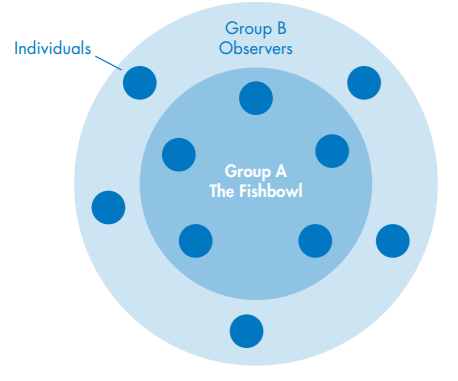
What is it?
Fishbowl is a discussion among students in an inner circle surrounded by an outer circle of silent active listeners. The inner group is asked to contrasting perspectives or particular roles. For example, they may debate a particular question or represent the contrasting viewpoints of public figures or thinkers. The outer group observes, and may swap into the group. The fishbowl concludes with a plenary debrief to draw out the main points.
Possibilities for fishbowl include consolidating students’ understanding of their preparatory work, assuming roles from a historical event, discussing an ethical dilemma, or adopting different positions on a disciplinary question.
Why do it?
Fishbowl is useful where there is a need to focus and deepen the conversation rather than dividing into separate groups, where the educator wants to give particular students a reason to speak and others to practice active listening, or where students tend to sit and interact in affinity groups and the educator wants to broaden their experience.
As well as requiring students to retrieve and apply their knowledge, it gives them an opportunity to articulate a point of view and deepen their understanding of it in relation to other perspectives. It is an occasion to practice and observe conversational approaches they need to master, such as backing up assertions with evidence, asking follow-up questions, paraphrasing, or elaborating on another student’s point.
How to set it up
Fishbowl works for groups of 6-30 students in a flexible space with room for two concentric circles. Assuming an open format where students will swap between the concentric circles, allow 45 minutes to one hour.
Before the session
- Think about how you will allocate students into groups. This could be voluntary, random or purposeful depending on whether you would like certain students to be able to speak or respond to each other.
- Develop the topic or prompt (see Considerations).
During the session
- Introduce the activity to students, including the benefits outlined above. If students are new to fishbowl, give the outer group some instructions about what to look out for, and (if swapping) negotiate how they would like to swap in and out of the inner circle (see Considerations).
- Ask students to help set up the concentric circles, with an inner group of a few chairs (as many as your topic needs), facing each other in the centre and an outer group (often larger) facing the backs of the chairs, who can either stand or sit.
- Split students into at two groups, one to take the chairs in the centre, and the other (often larger) to form the outer group of observers.
- The inner circle students participate in the discussion, facilitated by the educator.
- The outer circle observes silently and makes notes (perhaps analysing important moments in the conversation, or examples of where a kind of contribution worked well to move the discussion along).
- If the fishbowl is an open format (see Variations), students in the outer circle and may eventually swap with those in the inner circle (see Considerations).
Considerations
The topic or prompt should be open enough to draw out multiple perspectives. If you intend the outer and inner circle students to swap, it needs to be complex enough for at least 30 minutes of discussion.
The facilitator’s role is to remind students to practice desirable conversational approaches, and to ensure that important topics are discussed, and to enable the participation of every student.
When it comes to swapping in and out of the inner circle, this could be all at once at the facilitator’s prompt or initiated by a student. One way to organise the swaps is to put two extra empty chairs into the inner circle. When an outer circle student wants to contribute, they sit on an empty chair and the inner circle students collectively decide which of them will swap out. The facilitator ensures that each inner circle student has enough time to contribute fully.
If students are inexperienced and/or unfamiliar with each other, choose a question which isn’t likely to raise tensions they are not yet prepared to discuss. The SPARQtools ‘Are you ready to talk?’ toolkit is designed to prepare students for discussions which touch on identity. It includes question prompts for self-awareness, and a method (Listen, Affirm, Respond, Ask questions) for sensitive discussions.
If you know that some students will be reluctant to speak in front of the larger group, consider the Pinwheel variation, which involves smaller groups in preparing each position.
Larger cohorts may be organised into subgroups, allowing everybody a turn in the inner group.
Variations
Akin fishbowl
Here the inner circle comprises students who share an attribute, experience or position, allowing the outer circle insights into that perspective and its variation. It may incorporate the Feedback Fishbowl below.
Feedback fishbowl
This may work well in interprofessional or interdisciplinary settings. Each outer circle student is allocated one inner circle student to observe, and takes a position opposite them. After 15-20 minutes of discussion, each outer circle student gives feedback to their allocated student. The discussion then resumes as before, with the inner circle student incorporating the feedback. The outer and inner circle students then swap.
Source: ITC-ILO blog.
Parallel fishbowls
For larger cohorts see Pinwheel Discussions.
Examples and resources
- The Office of the High Commissioner for the United Nation Human Rights Commission has a substantial guide oriented to discussing human rights, including step-through guidance and variations.
- Facing History offers step-through guidance.
- Within its ‘Higher Ed Diversity and Inclusion’ collection, Stanford University’s SPARQtools have a step-through guide on a specific use of fishbowl to bring about honest conversations between people from different backgrounds.
- In action in a professional setting: video of an AudaCITY discussion among professionals on the subject of inclusion.
Image source: http://slitoolkit.ohchr.org/

Leave a Reply